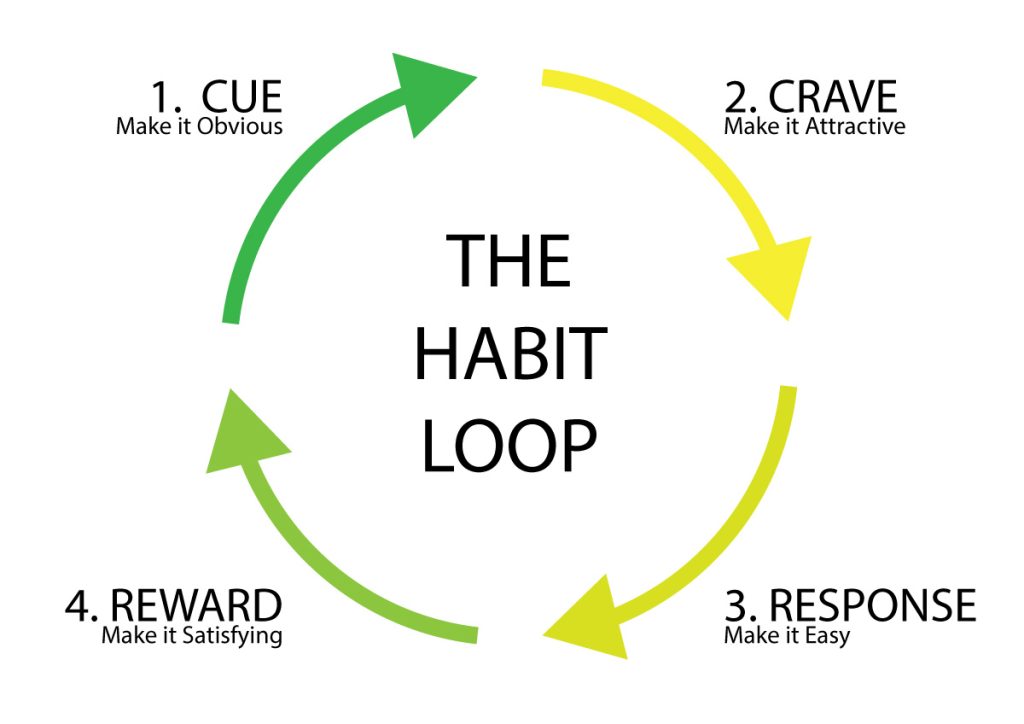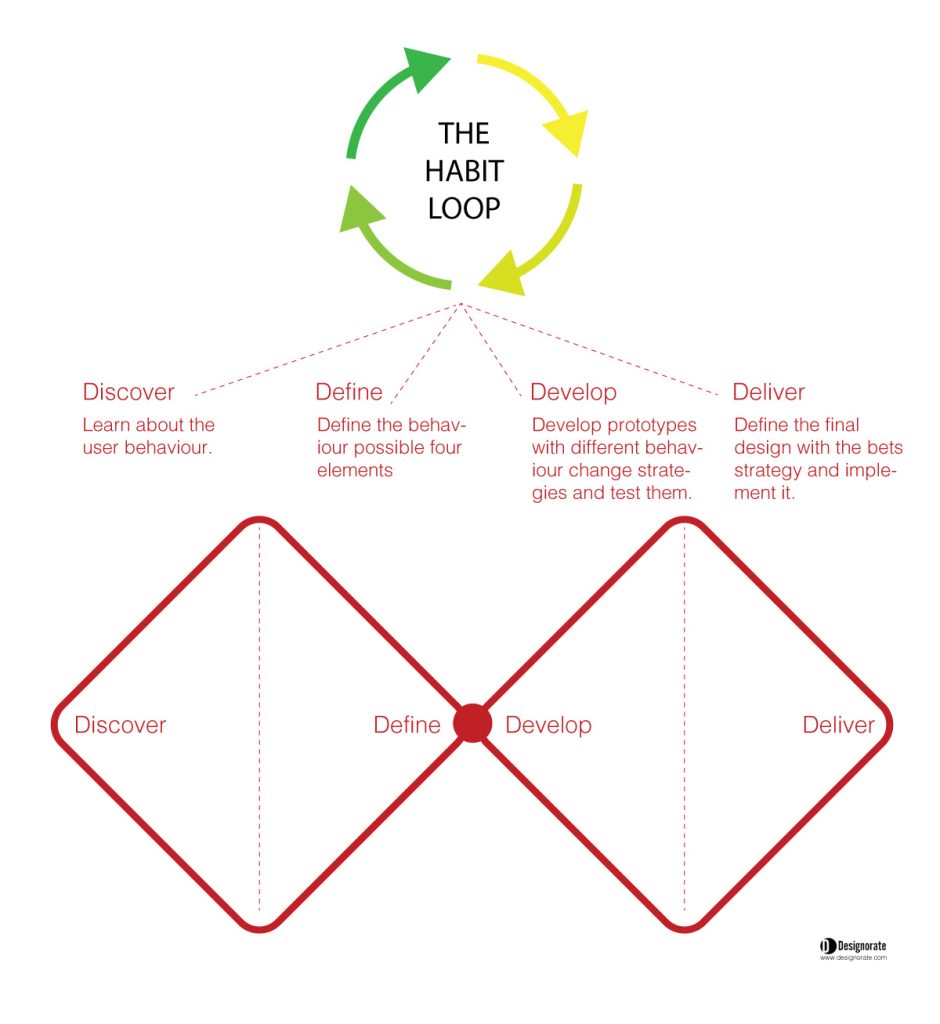Behavioural Design: Using Habit Loop in mHealth
Behavioural design is not only about designing the mobile health solution but also extending its role to understand how users behave and drive users to change their habits toward healthier ones, such as adhering to their medications or better managing their health. Think of how different social media platforms use behavioural science to alter user experience to stay engaged with the social media timeline: the like button, email notifications, and rewarding users as they scroll with more posts they enjoy or support.
First, what is behavioural design? Behavioural design is a design practice that utilises behavioural change theories in designing products, services, and systems in a way that aims to change users’ behaviour and habits to a desirable one.
Behavioural theories used in behavioural design are not new; they have been used in psychology, economics, education, and other fields. It is strange to see how much its application still needs to be extended in the healthcare technology. Patients with chronic diseases have been missing their medications for a long time, causing severe consequences such as mortality, financial loss, and medical complications. We started seeing doctor appointment mobile applications during the COVID-19 pandemic, dramatically reducing missed appointments.
There are several theories behind patient adherence and behaviour change, explored in detail during my PhD study (data published in my paper Implementing Evidence-Based Design to Improve Adherence in Self-Administered Treatment Technology), which I plan to explore in further posts. One very well-known theory is the habit loop and habit formation.
What is the Habit Loop (Habit Formation) Theory?
The habit theory focuses on the system (process) of developing the habit that triggers the behaviour change through four main stages that can trigger our behaviour either to build a new habit or eliminate a bad one: cue, crave, response, and award.
The theory is underpinned by a long history of psychological studies on how forming habits is the key to changing our behaviour. In 1890, Willian James reflected on the importance of habit: “habits cover a huge part of life” in his book, The Principles of Psychology. The theory is also influenced by the work of Thorndike’s Law of Effect in 1898 and the Formalised Drive theory by Hull in 1943. The nature of positive enforcement is coined in Skinner’s experiments (1938).
While the leading theory is based on three main stages (cue, response, and reward), the adapted four stages model has been introduced by recent authors such as James (Atomic Habits) and The Power of Habit: Why We Do What We Do, and How to Change by Charles Duhigg et al., which I believe presented the behaviour change theory in an easy to digest practical approach for anyone to apply to change their behaviour.

The four stages model is based on how we unconsciously react to external influences through building habits to present a reward for our brain. This reward can also mean reducing stress and eliminating pain or suffering. This principle is known in psychology as positive enforcement. These four stages include:
- Cue: this is the action that triggers the habit. For example, you may feel stressed from your workload, bad time management or depressed from bad news.
- Crave: in this stage, your brain starts to react to the situation at hand. You feel stressed from the workload or depressed from the bad news.
- Response: your brain starts to find a solution, an escape from the lousy experience. It is a try-and-error experience that happened unconsciously long ago—for example, eating more sweets to feel happy.
- Reward: more than the response is needed. The rewarding feeling of happiness is a crucial element to repeat the habit.
Many patients avoid visiting their doctor as this experience gives them the feeling that they are ill. Staying at home gives them the sense that they are OK. So, the doctor. Is it associated with feeling ill? This is why our brain avoids it.
Patients who forget to take their medication may not simply because they are lazy or forget it. It may be because they unconsciously run through the above four stages at some point. So, all we need to do is to be conscious about this process and interrupt it to change behaviour (check What is Kano Model Analysis? And How to Conduct it.).
The Habit Loop in the Design Thinking Process
In design thinking, we don’t need to add a function in a mobile app or a feature for a hospital service. Instead, we design experience that aims to make a change, which is where behavioural design comes in. It is a way to use behavioural theories such as the habits loop to drive users’ behaviour, which will subsequently reflect on the effectiveness of the design solution.
The design thinking process such as the Double Diamond design thinking uses the problem/solution frames to explore the root causes of the problem and dig deeper into the user experience to be able to provide a better experience, such in this case can be changing their behaviour to a healthy food diet, quit smoking, taking their pills on time…etc.

For example, if we are designing a mhealth app to help users practice more, we don’t need complex features and options; we only need to explore how to change users behaviour, which can come during the Discover stage to explore users’ experience, how to educate them to change their habit and use the application to help them drive the behaviour change. This approach can change the goal of the health app dramatically toward educating users rather than just influencing them.
Case Study 1: Klikkit
Klikket is a solution developed by Hablab, a Copenhagen-based company. The big problem in taking medication is poor adherence, especially in chronic diseases, as highlighted earlier. Klickitat is a button that can be attached to any medication or element associated with patient adherence, such as water bottles or exercise kits. The button is connected to a mobile app and desktop platform, allowing healthcare professionals to monitor patient adherence to the intervention, such as taking pills (also check What are the principles of Good Digital Healthcare Design?).
The Klikkit button provides recognised audio reminders to help patients remember their medications. As they click the button each time they take their medication or drink water, the data is saved on the mobile and web-based application that doctors can see to monitor the patient’s adherence to the prescribed regimen.

So, how does the habit loop apply to this case study? We can map the four stages of the habit loop behaviour change as follows:
- Cue: The reminder provides a cue to drive the patient’s attention to the habit (e.g., drinking water several times during the day).
- Crave: The patient wants to engage by drinking water, taking medication, or exercising.
- Engage: Patients start to engage with the medical regimen or the healthy habit. But more is needed; they click the button to record their achievement.
- Reward: The button clicks, and their progress are recorded through the application, giving a sense of reward.
The main problem when designing long-term habits such as brushing your teeth or drinking water is that the effect of the change doesn’t appear immediately. On the other hand, taking chronic disease medication over the long run makes patients bored or annoyed with the behaviour. So they can drop it after a few years, which puts them at risk of complications such as strokes.
The benefit of Klikkit is the small rewards that can transform adherence into a habit. By developing a habit, patients can stick with it as it becomes a subconscious behaviour. The case study provides an excellent example of using behavioural design to change patients’ habits toward an improve level of adherence to the healthy habits.
Case Study 2: Strata
The second case study for Straya is a mobile app and social networking for helping people change their behaviour toward a more healthy one through social connection with others who do different physical activities. The app uses the same concept of social networking as a driver of change. When we see a notification about an update from friends, we tend to hold our mobile phones to check and interact with it (also check Applying the Value Proposition Canvas in Healthcare Technology).

Straya uses the sample concept to encourage positive enforcement to increase physical activity. It allows users to record their activities and see and respond to their friends’ activities. The app notifications present the cue point where users get attached to the habit. Then, they crave to know what their friends are doing and their updates. The response here is to change their behaviour to a healthy one and interact with their friends. Finally, the reward is to be part of a healthy community and share user achievements and health activities.
Designing a successful mobile health app goes beyond just creating user-friendly features. We need to change users’ behaviour to a positive one, which is a successful outcome as it will help users change their behaviour in the short term and form a long-term habit.
One of the straightforward theories that drive behaviour change is the habit loop, which aims to build a long-term habit through four simple stages reflecting how our brains react to different situations through positive enforcement and rewarding, as we explored in the Klikkit and Straya case studies which illustrate the four stages of the cue, crave, engage, and reward.
Using the habit loop theory in design thinking requires exploring how users behave in each of the four stages, which can help design the health app that forms a habit and makes a sustaining change in the user’s life.



